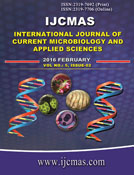


 National Academy of Agricultural Sciences (NAAS)
National Academy of Agricultural Sciences (NAAS)

|
PRINT ISSN : 2319-7692
Online ISSN : 2319-7706 Issues : 12 per year Publisher : Excellent Publishers Email : editorijcmas@gmail.com / submit@ijcmas.com Editor-in-chief: Dr.M.Prakash Index Copernicus ICV 2018: 95.39 NAAS RATING 2020: 5.38 |
Giardiasis is waterborne disease which had impact on public health in anywhere of the world, particularly in communities living under low level of sanitation and poor hygienic condition. Selection of such laboratory methods with high accuracy and precise technique recently had great role in reducing the rate of intestinal parasites in general and Giardia lamblia in particular. So the current study was conducted to fulfill this purpose. Three different microscopic based laboratory techniques namely direct double wet preparation, formal-ether and fecal stained smears by 9 different biological stains were applied for detecting Giardia lamblia stages in a total of 417 stool samples of Internal Iraqi Displaced peoples(IIDPPs) in Kirkuk city. The overall rate of Intestinal parasitic infection was 19.66%(82),,which included 10.31 %(43) as pure giardiasis and 9.35 %(39) for other 9 intestinal parasites. They involve: Blastocyst homonis 4.17 %, Entamoeba histolytica 1.67 %,Cryptosporidium parvum 1.43 %, Entamoeba coli 0.71 %, Cyclospora cayetanensis, 0.49 %, and 0.23 % for each of Entamoeba hartmani, Iodomoeba butschili, Hymenolepis nana and Ancylostoma duodenale. Statistically formalin-ether technique show high efficacy and significance than wet preparation technique in demonstrating other intestinal parasites. Eighty two positive samples were tested as fecal smears stained by nine different biological stains were examined by microscope. High rates of giardiasis 36.58 %.34.14 %,32.92 % and 25.6 % were recorded by using alcoholic eosin 1%, modified Gram staining+chromotrope 2R, alcoholic aceto-carmine 1 % and calcofluor white stains respectively. Followed by 24.39 %, 23.17 % and 19.15 % for Chromotrope 2R,trichrome stain and modified Ziehl-Neelsen stains respectively. While low rates 10.97 % and 7.31 % were recorded for haematoxyline-Ehrlich and 3 % of giemsa stain respectively. Giardiasis was contributing high rate from intestinal parasites among IIDPs,which had high healthy impact of this group of Iraqi communities. Fecal smears staining methods show high efficacy than direct microscopy and sedimentation technique in detecting and demonstrating Giardia lamblia microscopically, specially 1% of alcoholic eosin, alcoholic aceto-carmine and modified gram staining-hot chromotrope 2R stains.
 |
 |
 |
 |
 |